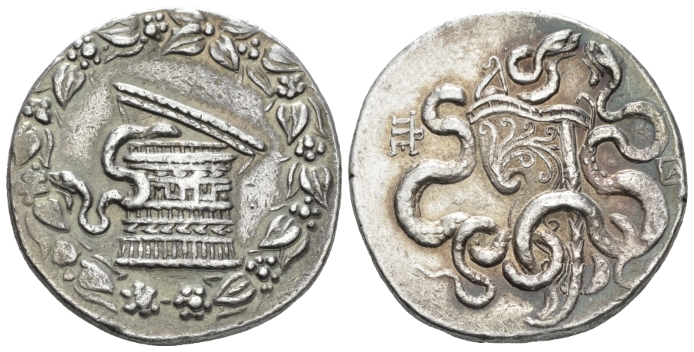Pergamum, silver, cistophori (166-123 BCE) Kleiner & Noe
From SILVER
166 BCE - 123 BCE Silver 42,555 kg
Description
| ObverseInscription or printing placed on the obverse.: | Serpent emerging from cista mystica, all within ivy wreath |
| ReverseInscription or printing placed on the reverse.: | (Greek).Two serpents entwined around bow and quiver, around three monograms |
Mint and issuing power
| MintIdentifies the place of manufacture or issue of a numismatic object.: | Pergamum | Ancient regionAncient region.: | Mysia | Modern countryModern country: Turkey | AuthorityIdentifies the issuing power. The authority can be "pretended" when the name or the portrait of X is on the coin but he/she was not the issuing power. It can also be "uncertain" when there is no mention of X on the coin but he/she was the issuing power according to the historical sources: | Attalid Kingdom |
Chronology
| FromIdentifies the initial date in a range assigned in a numismatic context. | 166 BCE | toIdentifies the final date in a range assigned in a numismatic context.. | 123 BCE | PeriodTime period of the numismatic object.: Hellenistic 323-30 BC |
Physical description
| MetalThe physical material (usually metal) from which an object is made.: | Silver |
Median weightMedian of the weights of numismatic objects (in grams). in grams | 12.70 | DenominationTerm indicating the value of a numismatic object. Examples: tetradrachm, chalkous, denarius.: | cistophorus |
StandardStandard.: | Cistophoric |
Image

H212 Pergamum cistophorus.jpg [1]
References
| Die study referencePublication of the study: | Kleiner - Noe 19771Kleiner - Noe 1977 | ||
| Coin series referenceReference to coin series study: | Sear II2Sear II, n° 3944-3946, RQEMH3RQEMH, n° 212 | ||
Obverse dies distribution
| FrequencyFrequency of specimen in distribution. ᵖ | Number of obversesNumber of obverse dies. ᵖ (o) | % (o) | Number of coinsNumber of coins. (n) | % (n) | Die nameName(s) of the die(s). |
| 1 | 44 | 36.67 | 44 | 14.72 | 4, 6, 8, 10, 11, 15, 19, 20, 22, 26, 30, 31, 33, 39, 43, 47, 55, 57, 59, 64, 67, 68, 69, 71, 74, 75, 78, 79, 80, 83, 85, 88, 92, 94, 103, 104, 105, 106, 110, 113, 115, 116, 119, 120 |
| 2 | 37 | 30.83 | 74 | 24.75 | 1, 5, 17, 18, 27, 29, 34, 36, 40, 42, 44, 45, 46, 49, 51, 56, 58, 60, 61, 63, 65, 70, 72, 73, 81, 82, 87, 90, 93, 95, 101, 102, 107, 108, 111, 114 |
| 3 | 18 | 15 | 54 | 18.06 | 3, 7, 13, 21, 24, 25, 38, 48, 66, 76, 84, 89, 91, 97, 109, 112, 117, 118 |
| 4 | 6 | 5 | 24 | 8.03 | 12, 35, 41, 62, 99, 100 |
| 5 | 7 | 5.83 | 35 | 11.71 | 14, 32, 50, 53, 54, 96, 98 |
| 7 | 2 | 1.67 | 14 | 4.68 | 2, 77 |
| 8 | 2 | 1.67 | 16 | 5.35 | 16, 28 |
| 9 | 3 | 2.5 | 27 | 9.03 | 9, 37, 52 |
| 11 | 1 | 0.83 | 11 | 3.68 | 23 |
| Total | 120 of 120 | 100 | 299 of 299 | 100.01 |
Reverse dies distribution
no distribution is available
Quantification
| Number of obversesNumber of obverse dies. ᵖ (o) | 120 | Number of singletons (o1)The number of singleton coins. ᵖ | 44 |
| Number of reverse diesNumber of reverse dies. (r) | 255 | Number of coinsNumber of coins. (n) | 299 |
| Coins per obverse dieNumber of coins per obverse die. (n/o) | 2.49 | Coins per reverse dieNumber of coins per reverse die. (n/r) | 1.17 |
| Reverse per obverse ratioRatio of obverse dies divided by reverse dies. (r/o) | 2.13 | Percentage of singletons (o1)number of coins (n) divided by the number of singletons (o1) ᵖ | 36.67 % |
| Original number of dies (O) (Carter 1983 formula)The estimation of the number of coins according to Carter 1983 ᵖ | 167.54 | Coins struck if 20,000 as average productivity per dieCoins made if the average productivity for obverses (according to Carter) is 20,000. ᵖ | 3,350,800 |
| Original number of dies (O) (Esty 2011 formula)The estimation of the number of coins according to the singleton formula in Esty 2011 ᵖ (O) | 200.45 | Survival rate if 20,000 as average productivity per dieSurvival rate if average productivity is 20,000. ᵖ | 0.00009 |
| Coverage (o = % of O) (Esty 1984 formula)Esty 1984 - coverage (% of O) ᵖ (o = % of O) | 85.28% | Die productivity if survival rate 1/2,000Average productivity if survival rate is 1/2,000. ᵖ | 3,569.3 |
| Weight of silver (in kg) if 20,000 coins per die (O = Carter formula)Carter 1983 * Median weight * 20000 (*10 if gold or electrum) ᵖ | 42,555 kg <br /> 42,555 kg | Die productivity if survival rate 1/5,000Average productivity if survival rate is 1/5,000. ᵖ | 8,923.24 |
Remarks
Working with the 2002 hoard, Lucia Carbone counts 79 coins for 49 obverses and 78 reverses.